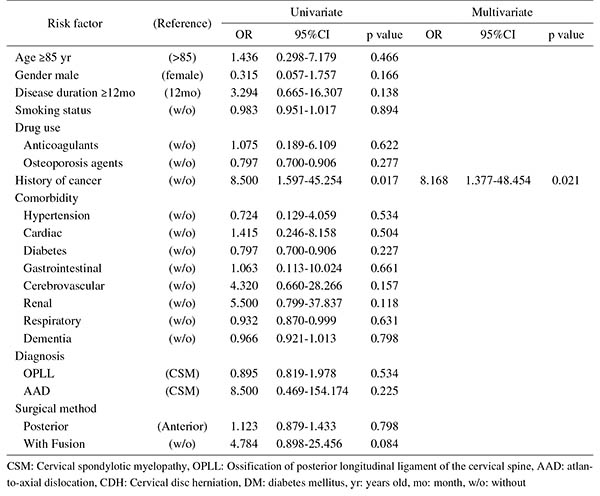- 著者
- Koji Tamai Hidetomi Terai Akinobu Suzuki Hiroaki Nakamura Masaomi Yamashita Yawara Eguchi Shiro Imagama Kei Ando Kazuyoshi Kobayashi Morio Matsumoto Ken Ishii Tomohiro Hikata Shoji Seki Masaaki Aramomi Tetsuhiro Ishikawa Atsushi Kimura Hirokazu Inoue Gen Inoue Masayuki Miyagi Wataru Saito Kei Yamada Michio Hongo Kenji Endo Hidekazu Suzuki Atsushi Nakano Kazuyuki Watanabe Junichi Ohya Hirotaka Chikuda Yasuchika Aoki Masayuki Shimizu Toshimasa Futatsugi Keijiro Mukaiyama Masaichi Hasegawa Katsuhito Kiyasu Haku Iizuka Kotaro Nishida Kenichiro Kakutani Hideaki Nakajima Hideki Murakami Satoru Demura Satoshi Kato Katsuhito Yoshioka Takashi Namikawa Kei Watanabe Kazuyoshi Nakanishi Yukihiro Nakagawa Mitsunori Yoshimoto Hiroyasu Fujiwara Norihiro Nishida Masataka Sakane Masashi Yamazaki Takashi Kaito Takeo Furuya Sumihisa Orita Seiji Ohtori
- 出版者
- The Japanese Society for Spine Surgery and Related Research
- 雑誌
- Spine Surgery and Related Research (ISSN:2432261X)
- 巻号頁・発行日
- vol.1, no.4, pp.179-184, 2017-10-20 (Released:2017-11-27)
- 参考文献数
- 26
- 被引用文献数
- 3 3
Introduction: With an aging population, the proportion of patients aged ≥80 years requiring cervical surgery is increasing. Surgeons are concerned with the high incidence of complications in this population, because "age" itself has been reported as a strong risk factor for complications. However, it is still unknown which factors represent higher risk among these elderly patients. Therefore, this study was conducted to identify the risk factors related to surgical complications specific to elderly patients by analyzing the registry data of patients aged ≥80 years who underwent cervical surgery.Methods: We retrospectively studied multicenter collected registry data using multivariate analysis. Sixty-six patients aged ≥80 years who underwent cervical surgery and were followed up for more than one year were included in this study. Preoperative patient demographic data, including comorbidities and postoperative complications, were collected from multicenter registry data. Complications were considered as major if they required invasive intervention, caused prolonged morbidity, or resulted in prolongation of hospital stay. Logistic regression analysis was performed to analyze the risk factors for complications. A p-value of <0.05 was considered as statistically significant.Results: The total number of patients with complications was 21 (31.8%), with seven major (10.6%) and 14 minor (21.2%) complications. Multivariate logistic regression analysis, after adjusting for age, revealed two significant risk factors: preoperative cerebrovascular disorders (OR, 6.337; p=0.043) for overall complications and cancer history (OR, 8.168; p=0.021) for major complications. Age, presence of diabetes mellitus, and diagnosis were not significant predictive factors for complications in this study.Conclusions: Preoperative cerebrovascular disorders and cancer history were risk factors for complications after cervical surgery in patients over 80 years old. Surgeons should pay attention to these specific risk factors before performing cervical surgery in elderly patients.
- 著者
- Atsushi KIMURA Shigeru SATO Takuma KATO Kentaro IKUTA Norio YAMAGISHI Keiji OKADA Hitoshi MIZUGUCHI Kazunori ITO
- 出版者
- JAPANESE SOCIETY OF VETERINARY SCIENCE
- 雑誌
- Journal of Veterinary Medical Science (ISSN:09167250)
- 巻号頁・発行日
- pp.1204120813, (Released:2012-04-20)
- 被引用文献数
- 17 22
To assess the relationship between pH and temperature in the ruminal bottom fluid, circadian changes were monitored using cows fed a control diet (C diet) or a rumen acidosis-inducing diet (RAI diet) by using a wireless radio-transmission pH- measurement system. These two parameters were measured simultaneously at 10-min intervals on day 14 after commencement of feeding. Compared to the mean ruminal pH for 60 min immediately after the morning feeding (0 hr), significantly lower pH was noted 3–13 hr later (P<0.05) and 4–19 hr later (P<0.01) in cows fed the C and RAI diets, respectively, although the reduction in the latter was much higher than that in the former. In contrast, significantly higher ruminal temperature was found at 8 and 12–14 hr later (P<0.05) and 6, 8, and 10–19 hr later (P<0.01) in cows fed the C and RAI diets, respectively. A significant negative correlation was observed between the lowest ruminal pH and its corresponding ruminal temperature in cows fed the C and RAI diets (r=-0.722 and -0.650, P<0.01, respectively), suggesting active fermentation and volatile fatty acid production in the rumen. However, ruminal pH profiles may not be predictable by measuring only ruminal temperature because decreases in ruminal pH were preceded by increases in ruminal temperature, and circadian changes in pH and temperature were associated with ruminal fermentation.
